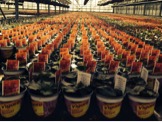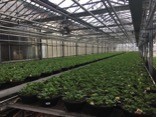James Langmayer, operations manager at Wood’s Greenhouse, doesn’t miss the days before remote temperature monitoring. One day about ten years ago he arrived on a bitter cold winter morning to begin his workday to discover that a heater malfunction destroyed the inventory of an entire greenhouse.
“We lost a few greenhouses that day because we didn’t have anyone working a night shift to go around and manually check the heaters,” he explained. “That was a gamble we decided never to take again.” He and his team began shopping for a remote monitoring system.
Founded in 1978 and based in Asbury, New Jersey, Wood’s Greenhouse is a family owned wholesale grower of premium annual plants. Their major partnership is with The Home Depot in the New York and New Jersey metro area. They also service independent garden centers and landscapers.
About ten years ago, Langmayer and his team began using Sensaphone remote monitors, and they still use six of the auto dialers today. “These devices have saved us from a lot of plant loss over the years,” Langmayer said.
Upgrading to Cellular, the Cloud & App
Langmayer monitors 40 zones throughout the greenhouses, each requiring its own temperature range. Recently, he upgraded to a Sentinel Cellular monitoring system. When he used the auto dialer monitors, Wood’s also paid a service to call its number each night. They would listen to the Sensaphones recite their messages just to make sure the temperatures were all in the right ranges, the boilers were running and the phones were working.
Wood’s opted to use the back-up service to check the messages because if the phone lines went down, the auto dialers wouldn’t be able to transmit any alerts. However, when the additional service became extremely expensive, it was no longer a practical, cost-effective solution.
His concern about landlines failing led Langmayer to investigate the Sentinel Cellular system. “This is a better option. We don’t have to use the back-up service or worry about phone lines,” he said.
Langmayer is especially impressed with the Sentinel’s cloud functionality. “It’s amazing and user-friendly for everybody. I can change all of the settings, disable the alarms, change recognition times, set high and low temperature limits right from the app,” he noted.
Another advantage of the cloud-based Sentinel is how easy it is to calibrate the temperature sensors. With the auto dialers, he has to listen at the base unit for the temperature reading, then run out to the greenhouse to make sure that the real temperature matches what the device is registering. If the numbers don’t match up, he has to repeat the process. “With the Sentinel I can just pull up the app and stay right in the greenhouse and calibrate the temperature,” he said.
The app also comes in handy on super-cold nights, when he knows that the heaters simply can’t keep the temperature in the pre-set ranges. On those occasions, he and his crew have to change the temperature limits, so they don’t get alerts all night long. However, because the auto dialers are busy doing their job of sending out notification calls, it’s difficult to call into the units to remotely change the temperature range. “With the app, I can easily access the unit and readjust the temperature settings,” he added.
Configuring the Monitors & Sensors
Langmayer keeps the Sensaphone monitoring units in two main locations—the main facility and a remote location on the property. Most of the Sensaphone units reside in the main facility with another in the boiler room where he uses this alarm system’s internal sound sensor to notify him when the boiler’s alarm goes off. The early warning gives him and his crew time to address the boiler failure before greenhouses get too cold and trigger a temperature alert.
Every greenhouse has its own dedicated heater and adding temperature probes are essential when monitoring for heater failures. He runs 50 feet to a few hundred feet of Cat5 cable in conduit underground to each greenhouse. Once inside, the cable is hung in conduit from the rafters and attached to 2.8k temperature probes that are located in the midd le of the greenhouse.
He also monitors for power failure, so they can react quickly to an outage and turn on the generators. However, he doesn’t see a need to monitor humidity. “In our operation, we don’t need monitors to tell us when humidity is building up.”
Working with Peace of Mind
Langmayer plans on ordering a second Sentinel unit and locating it in an area away from the first one, for added security. “Over my time here, the Sensaphone units have saved us from a lot of trouble. I must have received a hundred calls about legitimate problems,” he said. “If they save a greenhouse just once, they easily pay for themselves.”


